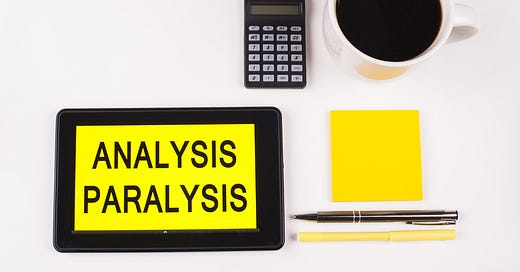Paralysis By Analysis
“Thinking too much leads to paralysis by analysis. It's important to think things through, but many use thinking as a means of avoiding action.” ~ Robert Herjavec
Not too long ago, I wrote about the Hierarchy of Effectiveness. Today, I will discuss another hierarchy, the Hierarchy of Correction – no pyramid graphics are needed this time.
I often use the Hierarchy of Correction when teaching martial arts, particularly to newcomers.
The Hierarchy of Correction is an exercise in prioritization. I see numerous things someone could improve, but I can’t bombard and overload them with a long list of critiques. They need simple, useful corrections. As such, I focus on a single correction (at most two) that will give the person the greatest immediate improvement and lay the foundation for future improvements.
Sponsor’s Message: BroThrow.com is building the most player-friendly company in sports gaming.
Our subscription-based, no-juice sports betting platform provides the fairest, simplest way to bet on sports with your friends.
Check out our tech: https://brothrow.com/
This isn’t an exact science. There are a lot of tradeoffs and calculations, particularly when working with someone with lousy technique, for lack of a gentler way to put it.
For example, if we are working on a jab-cross, and a brand-new student is standing with their feet together, hands down, punching timidly, and making many technical errors, I need to get their feet right first. That is more important than any other error they may be committing.
Once that is solved, I can focus on getting them to put their hands up. From there, it’s punching with more intent. Future corrections will be more technical: chin down and eyes up, punching from Point A to B and back to A, hip rotation, full extension, sitting on their punches, head movement, etc.
If I take that new student and give them the laundry list of corrections on Day 1, it will lead to paralysis by analysis. It’s just too much to take in.
“Separate your feet, keep your chin down and eyes up, try to put more hip rotation into it but don’t over-rotate, punch straight out and straight back, try to get your head offline on your punches, make sure you punch hard but not so hard you off-balance, and make sure you put your weight behind those punches. Oh yeah, and if you can, turn your shoulder over to protect your chin.”
Meanwhile, this person is standing with their feet together, hands at their waist, and punching with zero force – but maybe they have their chin glued to their chest and are shrugging their shoulders up because they don’t understand what chin down and turn your shoulder over even means.
Now, that doesn’t mean I don’t demonstrate or discuss all the intricacies during instruction, but when the student is practicing, and a correction is warranted, I focus on the most critical element or elements.
Some are simple fixes. Some require countless hours of practice to refine and constant vigilance to not slip back into the old habit. Some can be seamlessly added at any point in a person’s training. If left uncorrected, others turn into bad habits that are increasingly hard to eliminate.
And that’s where it gets tricky. If students try to fix the wrong things first, they develop hard-to-reverse habits that negatively seep into other areas, like tense, shrugged-up shoulders. Meanwhile, every repetition done with bad footwork or letting your hands drop makes it harder and harder to correct.
What does any of this have to do with the gambling industry? Quite simply, I see a lot of paralysis by analysis in two spheres: the responsible-problem gambling and regulatory spheres.
Keep reading with a 7-day free trial
Subscribe to Straight to the Point to keep reading this post and get 7 days of free access to the full post archives.




